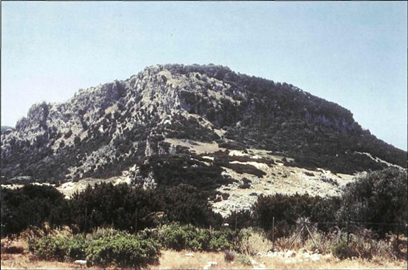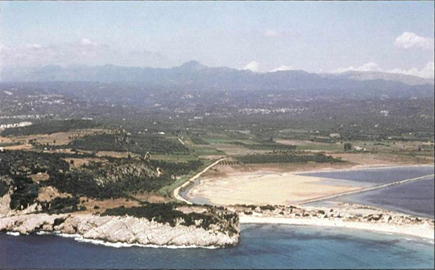Investigations in the vicinity of the palace of nestor
The tholos tomb appears to have been built toward or at the end of the Middle Bronze Age (ca. 1680 B.C.) and is thus the earliest of its type yet discovered in Greece. The tomb is located in a flat field, almost entirely buried underground. Dead were buried in pits and in large jars, the former with lavish offerings of vessels in precious metals and bronze weapons.

Figure 33. Palaionavarino and Cave of Nestor from Voidokoilia
Voidokoilia The shallow sea inlet surrounded by sand dunes west of Osmanaga Lagoon is called Voidokoilia (in Greek, "ox-belly") Bay because of its distinctive shape.20 At its western side rises the medieval fortress of Pylos at Palaionavarino (Old Navarino). On its northern slope, in the so-called Cave of Nestor (Fig. 33), excavations have recovered Neolithic pottery of the 4th millennium B.C. and of the Mycenaean period. On the rocky headland at the south end of Voidokoilia Bay are preserved the foun¬dations of buildings that belong to the ancient Greek set¬tlement of Coryphasion.21 Mycenaean pottery has been found beneath them, in the hollows of the bedrock.

Figure 34. Voidokoilia from Palaionavarino
For much more impressive prehistoric remains, visit the headland at the north end of Voidokoilia Bay (Fig. 34). Here Marinatos unearthed a small Early Mycenaean tholos tomb. Pausanias, a Greek traveler who visited the area in the 2nd century A.c, mentions a "monument" of Thrasyme-des, one of the sons of King Nestor, and Marinatos believed that this was his final resting place. Two human skeletons remained inside; the complete carcass of a cow appears to have been included as a grave gift. Recent excavations by George Korres of the University of Athens have now de¬monstrated that the tholos tomb was set into the remnants of a small Early Bronze Age village, dating to the later 3rd millennium B.C. Obsidian from the Cycladic island of Melos found in its buildings demonstrates the existence of trade and contact with the wider Aegean world. At the end of the 3rd millennium B.C. the promontory was transformed into a cemetery. Eventually a circular mound of earth and rubble about 1.5 m (nearly 5 feet) high was heaped up over the walls of the settlement and large jars were set into it as containers for human remains.